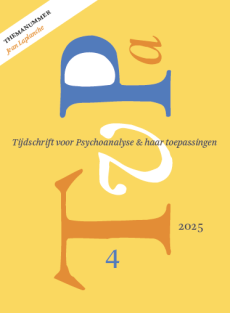Transitional space in cyberspace: de echte en de virtuele divan
Summary
Transitional space in cyberspace: the real and the virtual couch
Physical presence is no longer a prerequisite for social presence owing to the increasing technological means of synchronous communication. This article examines the potential and limitations of the use of telephonic, online chat and video communication within ongoing psychoanalytic treatment. The concept of virtual and its connotation with a computer-mediated fantasy world is explored. The author suggests a broader definition of virtuality which allows for the potentiality of a virtual couch in the continuation and development of an analytic process where this would otherwise be impaired because of geographical circumstances. Such a potentiality is based on the principle that the human capacity for fantasy and symbolization can break down the boundaries between the mental and the physical worlds.
Literatuur
- Bateman, A. & Fonagy, P. (2004). Psychotherapy for borderline personality disorder. Oxford: Oxford University Press.
- Beebe, B. (2005). Faces-in-relation Forms of intersubjectivity in an adult treatment of early trauma. In B. Beebe, S. Knoblauch, J. Rustin & D. Sorter (red.) (2005). Forms of intersubjectivity in infant research and adult treatment (p. 89-123). New York: Other Press.
- Benschop, A. (1997). Virtuele Gemeenschappen Bouwstenen voor een sociologie van het Internet. www.sociosite.org/netwerken.php.
- Curtis, A. (2000). Through the WEB and what Alice found there: the impact of the Internet on the therapeutic alliance. Psyche Matters, www.psychematters.com/papers/curtis.htm.
- Fenichel, M., Suler, J., Barak, A. e. a. (2002). Myths and realities of online clinical work. A 3rd year report from ismhos clinical case study group. www.rider.edu /~suler / psycyber / myths.html.
- Freud, S. (1905). Fragment van de analyse van een geval van hysterie (Dora). Sigmund Freud Nederlandse Editie: Ziektegeschiedenissen 2 (p. 25-157). Amsterdam: Boom.
- Grohol, J.M. (1999). Best practices in e-therapy Definition & scope of etherapy. http://psychcentral.com/best.
- Grotstein, J.S. (1995). A reassessment of the couch in psychoanalysis. Psychoanalytic Inquiry, 15, 396-405.
- Kakar, S. (2002). Travelling patient, mobile therapist. In J. Raphael-Leff (red.), Between sessions & beyond the couch (p. 40-42). Colchester: CPS Psychoanalytic Publications.
- Kuriloff, E. (1998). Winnicott and Sullivan Playing with the interpersonal mode in a transitional space. Contemporary Psychoanalysis, 34, 379-388.
- Leffert, M. (2003). Analysis and psychotherapy by telephone Twenty years of clinical experience. Journal of the American Psychoanalytic Association, 51, 101-130.
- Lindon, J.A. (1988). Psychoanalysis by telephone. Bulletin of the Menninger Clinic, 52, 521-528.
- Mitrani, J.L. (2001). Taking the transference Some technical implications in three papers by Bion. International Journal of Psychoanalysis, 82, 1085-1104.
- Nusselder, A. (2006). Interface fantasy A Lacanian cyborg ontology. Proefschrift, Erasmus Universiteit Rotterdam.
- Pally, R. (2001). A primary role for nonverbal communication in psychoanalysis. Psychoanalyic Inquiry, 21, 71-94.
- Pascual-Leone, A., Nguyet, D., Cohen, L.G., Brasil-Neto, J.P., Cammarota, A. & Hallett, M. (1995). Modulation of muscle responses evoked by transcranial magnetic stimulation during the acquisition of new fine motor skills. Journal of Neurophysioly, 74, 1037-1045.
- Richards, A.K. (2001). Talking cure in the 21st century telephone analysis. Psychoanalytic Psychology, 18, 388-339.
- Saul, L.J. (1951). A note on the telephone as a technical aid. Psychoanalytic Quarterly, 20, 287-290.
- Schore, A.N. (2003). The human unconscious: the development of the right brain and its role in early emotional life. In V. Green, Emotional development in psychoanalysis, attachment theory and neuroscience (p. 23-55). Hove / New York: Brunner-Routledge.
- SCP: Sociaal en Cultureel Planbureau (2003). Het theorema van Thomas. Speciale uitgave 18.
- Suler, J. (1998). The psychology of cyberspace Mom, dad, computer Transference reactions to computers. www.rider.edu /~suler/psycyber/comptransf.html.
- Suler, J. (2000). Psychotherapy and clinical work in cyberspace. www.rider.edu/~suler/sycyber/therintro.html.
- Suler, J. (2004). The online disinhibition effect. www.rider.edu/~suler/psycyber/disinhibit.html.
- Suler, J. (2005). The basic psychological features of cyberspace. www.rider.edu/~suler/psycyber/basicfeat.html.
- Summers, F. (1999). Pychoanalytic boundaries and transitional space. Psychoanalytic Pychology, 16, 3-20.
- Time Magazine (2006). Second Life & Amazing Embrace. Joel Stein tours the weird new virtual world. Time Magazine, 168, No.27 /28.
- Wernick, P. (2007). Persoonlijke medeling.
- Winnicott, D.W. (1968). The use of an object and relating through identifications. In C. Winnicott, R. Shepherd & M. Davis (red.), D.W. Winnicott Psycho-analytic explorations (p. 218-228). Londen: Karnac, 1989.
- Zalusky, S. (1998). Telephone analysis: out of sight, but not out of mind. Journal of the American Psychoanalytic Association, 46, 1221-1242.
 © 2009-2025 Uitgeverij Boom Amsterdam
© 2009-2025 Uitgeverij Boom Amsterdam
ISSN 1382-516x
De artikelen uit de (online)tijdschriften van Uitgeverij Boom zijn auteursrechtelijk beschermd. U kunt er natuurlijk uit citeren (voorzien van een bronvermelding) maar voor reproductie in welke vorm dan ook moet toestemming aan de uitgever worden gevraagd:
Behoudens de in of krachtens de Auteurswet van 1912 gestelde uitzonderingen mag niets uit deze uitgave worden verveelvoudigd, opgeslagen in een geautomatiseerd gegevensbestand, of openbaar gemaakt, in enige vorm of op enige wijze, hetzij elektronisch, mechanisch door fotokopieën, opnamen of enig andere manier, zonder voorafgaande schriftelijke toestemming van de uitgever.
Voor zover het maken van kopieën uit deze uitgave is toegestaan op grond van artikelen 16h t/m 16m Auteurswet 1912 jo. Besluit van 27 november 2002, Stb 575, dient men de daarvoor wettelijk verschuldigde vergoeding te voldoen aan de Stichting Reprorecht te Hoofddorp (postbus 3060, 2130 KB, www.reprorecht.nl) of contact op te nemen met de uitgever voor het treffen van een rechtstreekse regeling in de zin van art. 16l, vijfde lid, Auteurswet 1912.
Voor het overnemen van gedeelte(n) uit deze uitgave in bloemlezingen, readers en andere compilatiewerken (artikel 16, Auteurswet 1912) kan men zich wenden tot de Stichting PRO (Stichting Publicatie- en Reproductierechten, postbus 3060, 2130 KB Hoofddorp, www.cedar.nl/pro).
No part of this book may be reproduced in any way whatsoever without the written permission of the publisher.
Nieuwsbrief Boom Psychologie
Meld u nu aan en ontvang maandelijks de Boom Psychologie nieuwsbrief met aantrekkelijke aanbiedingen en de nieuwe uitgaven.
Aanmelden


